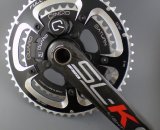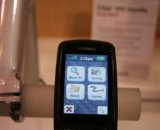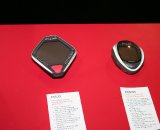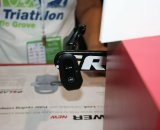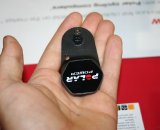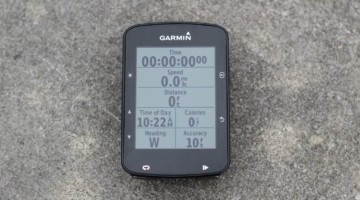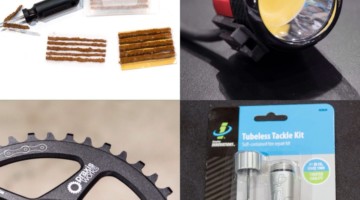Why would a cyclocrosser want to invest in a power meter? The obvious benefit is to use one during training, whether for hitting prescribed wattage marks for intervals, or for tracking progress and fitness from week to week – and, potentially over years of cycling.
But more and more ’crossers are bringing watt meters out on the course, too. Although it could be useful to make sure you’re maintaining a hard but sustainable pace on certain straightaway sections or climbs, for example, the main benefit is to review data afterward. Many modern head units will record not only power, but your heart rate, speed, the temperature, altitude and elevation gained/lost. And those that are equipped with a GPS will automatically track your lap times, so you can see if you’re starting too hard and fading, or conversely if you’re finishing with too much in the tank. Quarq has positive developments on its already-existing Saturn power meter, and both Garmin and Look/Polar have pedal-based power meters hitting the market soon.

Garmin's newest employee, Clark Foy, with Jake Jacobson. Understandably, we weren't allowed to photo the in-progress unit © Josh Liberles
Garmin / Metrigear
The big story the day before Interbike kicked off was that Garmin had acquired Metrigear, a company that had made waves at last year’s industry trade show with the prototype of their pedal-based power meter. The circuitry for the power meter is housed inside the pedal’s spindle, where it’s well-protected from the elements. The three features that should set the Metrigear product apart are: pricepoint –$1,000 was the target, although that may shift under Garmin; ease of swapping between bikes – just swap pedals and go; and the light weight at just 50 grams for the circuitry and ANT+ transmitter. And because the system uses ANT+, you can use your favorite ANT+ compatible computer head. Don’t be surprised if Garmin comes out with packages with their popular head units, which are currently some of the most popular on the market.
Other unique aspects to this power meter setup is the instantaneous cadence data from the unit’s accelerometer – which means you see the relative strong and weak spots of your pedal stroke – and the ability to detect power output of your right and left legs separately.
With the Garmin team involved, the product launch date can’t be far off. As Clark Foy, formerly one of the Metrigear partners and now Garmin’s category manager for power, said, “The sensor is nailed. With the Garmin Fitness team, manufacturing and industrial designers on board, an excellent final product will be here soon.”
When asked how the power meter would be for tougher conditions like cyclocross and mountain biking, Jake Jacobson of Garmin replied, “Nobody designs rugged better. In Iraq, we have military guys bringing Garmin GPS units along with their military issue unit for its reliability.”
Expect road and cyclocross/mountain biking packages to be available, although specific pedal model offerings have not yet been confirmed.
Garmin also just released its new Edge 800 GPS unit. Although it’s a little big to use during a race (the smaller, more reasonable 500 unit sans mapping is just the ticket for that), it’s great for training. Pre-load a cool ride you find online or use mapping software to program one for yourself, then just follow the arrows on your screen either on the road or into the woods. The new GPS has a touch screen which is glove friendly “from full finger gloves to full-on mittens,” according to Jacobson, “and has a better touch screen than the iPhone. It’ll survive the worst storm ever, too.”
MSRP: on the pedal-based power meter is TBD; Edge 800 is $449 for the bundle with heart rate monitor, speed and cadence sensor, and SD card for turn-by-turn mapping.
Quarq
Quarq’s crank-based power meters aren’t new – the first generation launched about two years ago now – but they have some new add-on features that address some of the biggest complaints against them. In a short time, they’ve become one of the most sought after power meters for their relatively reasonable price, accuracy, user serviceability and ease of swapping between bikes. As Quarq’s Kai Gonzales pointed out, “It’s the accuracy of an SRM at a much lower price point and lower overall weight – and you don’t have to mail in the unit and wait for it to return every time you need to change a battery.” The MSRP on the Quarq Saturn power meter is $1495 and the battery is easily accessed and replaced by the customer.
Although moving the cranks between bikes is super straightforward thanks to external bottom brackets, swapping chainrings can be a bit more complex. Because the unit’s uses strain-gauges (20 strain grids on 10 gauges) measures power at the crank arm, changing chainrings can influence overall stiffness. However, according to product specialist Tony Diem, the company has tested the Quarq Saturn mounted on SRAM cranks with a 53/39 road setup, a 48/39 cyclocross setup and a single ring cyclocross setup and found that all three were within the necessary 2% tolerance and didn’t need to be recalibrated. However, if you switch to large, solid time trial rings, for example, a recalibration will be necessary. Luckily, soon that won’t be as much of an ordeal as it used to be.
While recalibration used to mean sending the cranks back into Quarq, that’s changing. There’s an app for that, and it’s called Qalvin. Wahoo Fitness has manufactured a dongle to allow iPhones and iPads to connect to the Saturn power meter unit. Currently the app can only report on the calibration and accuracy, but a firmware upgrade coming in 2011 will allow the iPhone to recalibrate the power meter.
For those enamored with the SRM head unit, the Quarq Saturns are now capable of dual broadcasts and can communicate with both the SRM PCVII as well as any ANT+ enabled device. The According to Diem, all Droids have ANT+ capability, but that feature is currently disabled on the units. Once Google enables ANT+ via a firmware upgrade, Quarq has Droid-specific software ready to go that will enable the units to communicate with the Quarq power meters without a dongle.
Coming soon for cyclocrossers: Quarq will offer units assembled with cyclocross-specific rings and single ring setups with bash guards by 2011.
MSRP: $1,495 for Quarq only when you supply crank, pre-built options also available. The Qalvin app is a free download, but the dongle necessary for iPhones/iPads in $80 from Wahoo Fitness.
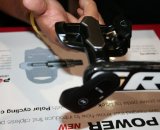
The Look Keo power pedal platform is the same tried-and-true interface as Look's current road models © Josh Liberles
Look / Polar
Look and Polar have joined forces to produce a pedal-based power meter as well. For now, only a road model is being offered, built around the Look Keo pedal. Like the Garmin/Metrigear product, separate data will be collected from the left and right pedals, and moving between bikes is as easy as swapping pedals – which is great for road and time trial applications, but there’s been no news of an off-road / cyclocross offering yet. However, this system relies on one of three Polar computers and is not compatible with other head units, ruling out the possibility for GPS features.
The system uses 8 gauges per axle, and the sensors are inside the pedal. Plans for a power platform build on the popular Look Quartz MTB pedal haven’t been announced, but once the road system is complete, they can’t be far behind.
MSRP: $2,000 for Look Keo Power, not including head unit
Photo Gallery:













